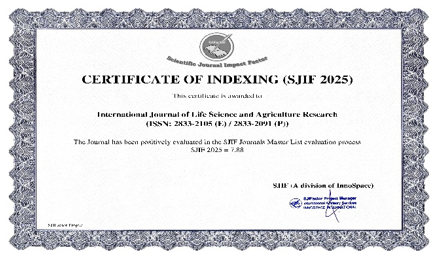Local Wisdom of the Community of Rambangaru Village, Sumba District, East Nusa Tenggara East in the Cultivation of Sandalwood Plants (Santalum Album L.)
DOI:
https://doi.org/10.55677/ijlsar/V03I8Y2024-08Keywords:
Local_Wisdom, Rambangaru, Sandalwood_Plant, SumbaAbstract
The sandalwood plant (Santalum album L.) originates from the Indonesian islands in the southeast, mainly on Timor Island and Sumba Island, according to some experts. It is one of the 25 tribes of the Santalaceae and is spread throughout Asia. The communities in the village of Rambangaru are very helpful to the government of East Nusa Tenggara Province with the conservation, cultivation, exploitation, and processing of sandalwood. The Haharu community hopes to support their efforts to preserve and grow sandalwood plants both outdoors and in the courtyard. Sandalwood is an important plant for local communities in Rambangaru Village, Haharu district, and therefore needs further conservation efforts. The aim of the research is to explain the cultivation techniques of sandalwood plants (Santalum album L.) in Rambangaru village in Haharu district of East Sumba. The qualitative method is a paradigm for describing an event or a society's behavior in detail and in depth in the form of a narrative. The results of the research showed that the cultivation technique of sandalwood plants in the village of Rambangaru, Haharu district, is a single and double planting technique. The community of Rambangaru village has its own technique for planting sandalwood seedlings. The techniques used are single and double planting. Single planting is done using only one guest plant when sandal wood seedlings are planted, while for dual planting, it takes 2–5 guest plants at the time of planting sandalwood seedlings.
References
Achamad, H. (2021) Solute Chemistry. Bandung: PT. Image Aditya Bakti.
Anonymous. 2010. What do you mean by an imbibition event? Accessed on September 18, 2012. http://vansaka.blogspot.com/2010/03/what-meaning-with-events.html.
Arifriana R., S. Indrioko, and A. Syahbudin. 2017. Variation of Sandalwood (Linn album) Based on the Morphology of Leaves and Flowers in Lightning Village, Rongkop, Kidul Mountain. Journal of Forest Science. https://jurnal.ugm.ac.id/jikfkt. 97-108.
Lestari, F. 2010. Flowering Characteristics of Three Provenan and Four Sandalwood Land Races. Journal of Forest Plants Cultivation, 7(2); 59-65.
Limbu, N. U., Kriswiyanti, E., & Astarini, I. A. (2023). Ethnobotany Study on the Use of Sandalwood Plants (Santalum Album L.) in Haharu district of East Sumba East Nusa Tenggara. 1.
McWilliam, A., 2005. Haumeni, Not Many: Renewed Plunder and Mismanagement in the Timorese Sandalwood Industry. Modern Asian Studies, 39 (2), 285-320.
Michelle A. R., Annatasia M., Jonathan F., Kevin J. M., Yusril M. P., Mohamad F. A., Emanuel D. A. S., Tri A.P., Caesario H. I., Rian D. K., Leonie M. W. P. 2021. The planting, care and cultivation of Sandalwood as an effort to enhance the potential of the box village. (JAI). 2775 (1); 9113
Njurumana, G. N., M, D. M., I, I. I., & S, R. S. (2014). Sandalwood Conservation (Santalum Album Linn) is a society based on the Kaliwu system on Sumba Island. Journal of Environmental Science, 11(2), 51. https://doi.org/10.14710/jil.11.2.51-61.
Santha S. and C. Dwivedi. 2015. Department of Pharmaceutical Sciences, South Dakota State University, Brookings, SD, U.S.A. Journal of Anticancer Research, (35); 3137-3146.
Sumardi M. H., D. Yuniati, and B. A. Victorino. 2016. Land Adequacy Analysis for Sandalwood Cultivation (Santalum album L) in East Island. (Available online); www.jurnal.balithutmakassar.org.i(1);61-77; Accessed on November 29, 2018.
Sumanto S. E, E. Sutrisno, and H Kurniawan. 2011. Forestry Policy Analysis and Strategy in Sandalwood Development in Southeast Nusa. Copang Forestry Research Hall, 8 (3); 189-209.
Surata IK and Purwadi A. 1993. Sandalwood Forestry Technology Preparedness. Proceedings of the Sandal Wood Conservation Monitoring Seminar in East Nusa Tenggara Province, Forestry Service of East Nussa Tenggara, Kupang.
Surata IK. 1998. Sandalwood forestry and its problems. Internal technical report. Forestry Research Hall, Kupang.
Surata IK. 2006. Status of Sandalwood Research in East Nusa Tenggara Province. Forestry Research and Development Halls of Bali and South Nusa, (21) 7-10.
Surata K.I. 2010. Intensification of Sandalwood Development (Santalum album L) With Sari Tumpang Pattern in East Nusa Southeast, Prosiding National Seminar of Litbang Contribution in Increasing Forest Productivity and Sustainability, Forest Plants Pathway Increase in Productiveness, Bogor, November 29, 2010.
Downloads
Published
Issue
Section
License
Copyright (c) 2024 International Journal of Life Science and Agriculture Research

This work is licensed under a Creative Commons Attribution 4.0 International License.












